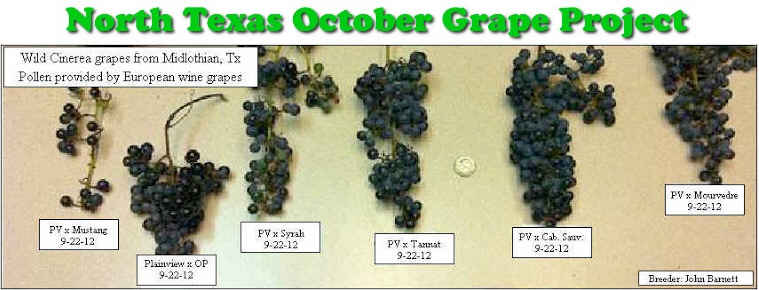Here is a comparison of grape flowers in the west vineyard. All three pictures were taken this evening.
This is a wild mustang. It was here before we started the vineyard. It blossomed, today. Note the pistol and stamen on the open blossom. This is a female grape flower. The stamen will not produce pollen.
This is Bridlegate cinerea x Carnelian. This is a week or so from blossoming.
This is Plainview cinerea. It is a wild vine. We planted a cutting of it last year. The blossom will probably open in 3 weeks.
The mustang and cinerea are wild vines, and have used different strategies for handling the late frosts we have here in Central Texas. Mustangs start early and often suffer from a late frost. It doesn't seem to bother them though. The vine is covered with blossoms. The cinerea seems to simply start late. This may be the latest vine to blossom in the vineyard. Late is fine for cinerea, its berreis won't ripen until late October or November.
In the middle is a vine whose 'mother' was the Bridlegate cinerea. The pollen parent was the vinifera Carnelian. It is somewhere in between. Vinifera is generally early, earlier than mustang. It doesn't have any of the 'smarts' the mustang displays, though. They get wiped out by late frosts. It looks like this cross is taking the cinerea route and blossoming late. It is no where as late as the Plainview cinerea, though.
We have had both late and super-late frosts this year. It isn't clear to me that cinerea and cinerea crosses are going to put out a lot of blossoms, so their delay strategy may not be as robust as I'd like. I think we could use a bit of both mustang's 'smarts' and cinerea's 'delay' factor in the 'October Grape'. Based on what is going to flower here this year, rupestris and doaniana both share the mustang 'smarts' factor. Unfortunately, they ripen very early. Maybe there is something we can do to get the early bird smarts into cinerea and still avoid bringing the early ripening date along with it.
Sunday, April 21, 2013
Sunday, April 7, 2013
2012 Cinerea wine
John Barnett and I tasted his 2012 Plainview Cinerea, Friday. It was a 'one bottle batch'. John thought it went bad early in
fermentation, but added some sugar and things seemed to turn around.
It definitely was not vinegar. It was a sweet red with a very dark red color. Alcohol content was high.
Acid was probably low. My comment was 'fruity, but the fruit is all bundled up'. John thought the grapes had raisined (he picked the berries in November).
My other comment was, 'it is a bit like fruit juice, not wine. It doesn't have much bite.' This might be a lack of tannins.
There were no odd overtones. No grass, no herbs, no labrusca.
We sat around and had a nice conversation on John's porch, watching the sun set. Contributing to conversation is high on my list of wine qualities, so I was very impressed.
It definitely was not vinegar. It was a sweet red with a very dark red color. Alcohol content was high.
Acid was probably low. My comment was 'fruity, but the fruit is all bundled up'. John thought the grapes had raisined (he picked the berries in November).
My other comment was, 'it is a bit like fruit juice, not wine. It doesn't have much bite.' This might be a lack of tannins.
There were no odd overtones. No grass, no herbs, no labrusca.
We sat around and had a nice conversation on John's porch, watching the sun set. Contributing to conversation is high on my list of wine qualities, so I was very impressed.
Subscribe to:
Posts (Atom)




